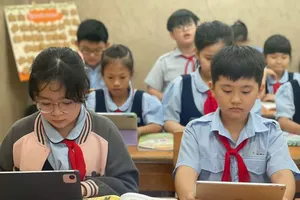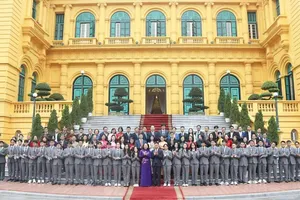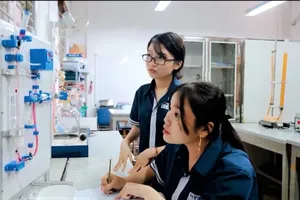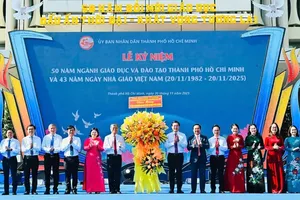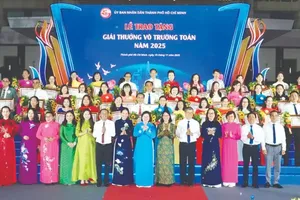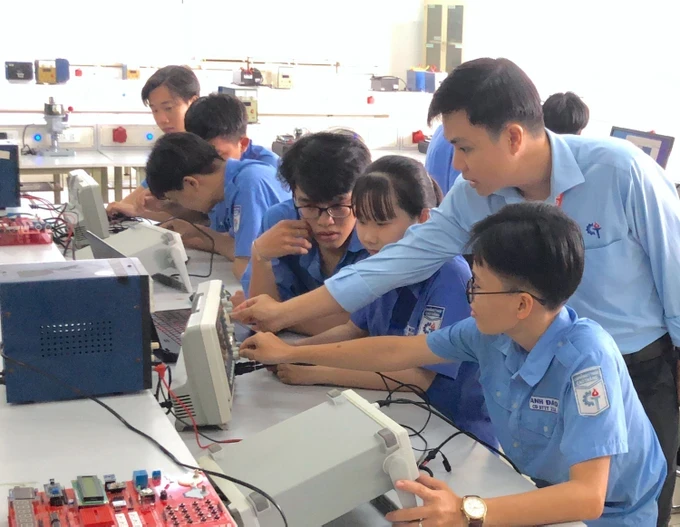
Following updated guidance from the Ministry of Education and Training, many vocational schools are retaining their previous admission methods while fine-tuning subject combinations to align with the 2018 General Education Program. Crucially, they are also expanding the array of recruitment pathways to provide greater opportunities for candidates.
President Le Dinh Kha of Cao Thang Technical College in HCMC reported the school aims to recruit 4,500 students across 18 majors this year, utilizing four distinct admission methods. These include selection based on academic transcripts from four semesters (semesters 1 and 2 of the 11th and 12th grades), direct admission, consideration of high school graduation exam results, and acceptance based on scores from the Vietnam National University – HCM – Academic Competence Test (V-ACT).
The college employs a three-subject combination for assessment, with Math as a compulsory subject weighted with a coefficient of 2; the other two subjects can be chosen from Physics, Chemistry, Literature, English, Informatics, or Technology.
President Le Dinh Kha noted, “This year, we’ve introduced a direct admission method, accounting for 15 percent of our intake, with criteria such as a letter of recommendation from former students or lecturers, or demonstrating excellent academic performance in the 11th or 12th grade.”
This year, Ly Tu Trong Technical College in HCMC plans to admit 8,600 students across its college and intermediate levels, offering 49 majors. Notably, the college is introducing new majors in Chinese Language, Construction Woodworking – Interior Decoration, and Fashion Design. Vice President Chau Van Bao of the college explained, “The introduction of these three new majors aligns with current trends. They represent fields where businesses are facing a deficit of skilled, highly specialized human resources.”
Other vocational training institutions are also actively recruiting. College of Industry No.II in HCMC is targeting 885 students across 30 majors at the college and intermediate levels. HCMC College of Economics is recruiting 3,200 students; for college-level programs, applicants can be considered based on academic transcripts or high school graduation exam scores, using subject combinations including mandatory Math from any subjects in the general program. Viendong College in HCMC is recruiting 1,500 students, with 70 percent of the intake based on high school academic transcripts and V-ACT scores, while the remaining 30 percent relies on high school graduation exam results.
To elevate the standard of training and enhance their appeal to prospective students, vocational schools are developing curricula closely aligned with practical demands and the needs of the labor market. These training programs typically allocate 30 percent to theory and 70 percent to hands-on practice, with continuous updates to reflect real-world conditions. Furthermore, during the training process, schools prioritize selecting businesses for student internships and practical placements, specifically to equip them with relevant, sought-after skills.
According to Assoc Prof Dr Bui Van Hung, President of College of Industry No.II, the institution is utilizing digital platforms for enrollment alongside traditional direct counseling sessions held at the college and at junior and high school locations throughout HCMC and other provinces. To attract vocational learners, the college offers various support policies, including scholarships and tuition waivers or reductions, particularly for students covered by the Ordinance on Preferential Treatment for People with Meritorious Services to the Revolution and students with disabilities.
According to Deputy Head Vu Quoc Binh of the Department of Vocational Education and Continuing Education (Ministry of Education and Training), achieving enrollment targets necessitates proactive early outreach in schools and society, enabling students to gain firsthand exposure to professions and discern career pathways. Building a robust bridge connecting vocational education with the labor market is essential for practical experience. Vocational schools must also elevate training standards, aiming for 70 percent national and international benchmarks to instill confidence and attract students.
President Tran Kim Tuyen of HCMC Vocational College stated that while striving to meet the 4,000 student intake target across its training systems, ensuring graduate employability is a foremost priority. “In our training approach, the school maintains strong ties with enterprises”, President Tran Kim Tuyen explained. “We currently benefit from the support of about 100 businesses, ensuring that the human resources we train are not only prepared for the domestic market but also capable of catering to international markets.”
Demonstrating a commitment to developing a localized workforce for Long Thanh International Airport, Lilama 2 International Technology College is collaborating with Aircraft Engineering One Member Co. Ltd., Saigon Ground Services JSC, and Vietnam Airlines Corporation to train approximately 48,000 laborers for the airport during the 2024-2026 phase, with an orientation towards 2030, facilitating job placement both within and outside the airport complex. The training encompasses various aviation professions, including Aircraft Maintenance, Aircraft Structure Repair Engineering, Aviation Equipment Operation, and Aviation Staff Operations.
HR forecasting experts indicate that the opening of new majors by vocational schools is an unavoidable trend driven by the significant transformation of the economic landscape and the increasing diversity of professions. The crucial element, they stress, is to reinforce oversight and quality assurance for these newly introduced training programs.
Beyond incentives like scholarships and tuition waivers, the fundamental determinant for prospective learners confidently opting for vocational training remains the assurance of job placement upon graduation, delivered as promised.
In a related development, the Ministry of Education and Training is currently soliciting feedback on the draft amending and supplementing the Law on Education. This draft includes significant revisions to provisions concerning credentials and certifications within the national education framework.
Specifically, the draft proposes amendments to Articles 12, 34, as well as Clauses 2 and 3 of Article 45 of the current Education Law. These changes suggest the removal of the junior secondary school graduation certificate, instead assigning school principals the authority to confirm the completion of the junior secondary program in the student’s academic transcript. Furthermore, the authority to issue high school graduation diplomas would be delegated to high school principals, removing the procedure previously performed at the Department of Education and Training.
These proposed amendments align with practical needs and thoroughly implement decentralization and devolution of authority. They also comply with the principle that “where training takes place, diplomas are issued”, which is in line with international norms. The Ministry asserts that confirming the completion of the junior secondary program in the academic transcript will not impact the rights and obligations of learners.
